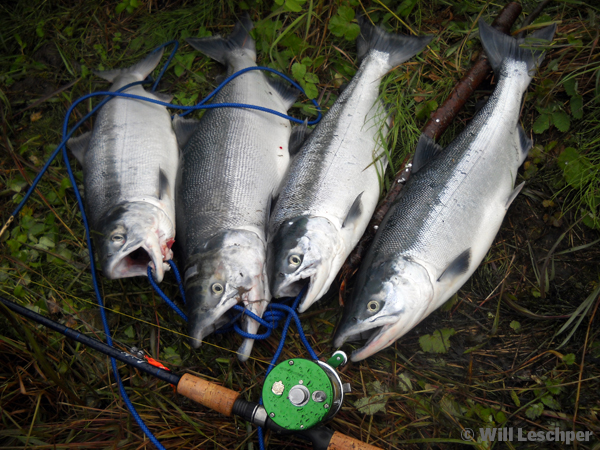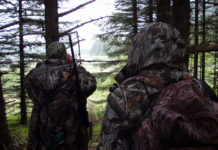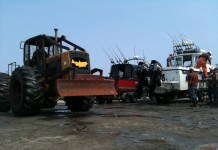KENAI RIVER, Alaska — The sweeping, familiar silhouette in the bluebird sky sways decisively in the nighttime breeze. It’s a couple of hours to the start of a new day, and in the hovering glow the eagle descends to an evergreen perch with nimble strides.
The inquisitive bird of prey easily could be mistaken for a statue in between the curious habit of craning its neck to get a better bird’s-eye view of the bustling world below.
Upriver and downriver the shorelines and shallows teem with activity as anglers of all shapes and sizes slowly retrieve their barbed offerings against the surging current hoping for a hefty resistance. Below the churning surface, it’s the same lively story as bright sockeyes that only hours before were swimming in chilly saltwater flows dash against the grain up this fresh water highway to spawn.
Minutes after plopping down, it becomes evident the newest sentinel along this stretch of fabled fishery isn’t the only new arrival. Along the bank in the distance an angler with conventional tackle and another standing beside with heavyweight fly tackle rear back as the pair of salmon they hook peel drag and jump wildly. Almost in unison the domino effect continues its path down the shoreline as another wave of sockeyes charges above the weathered rocks along the bottom of the river and multiple anglers do their best to land surging fish in what has become a thrashing rodeo.
Welcome to another summer in Alaska.
June, July and August are magical months for anglers in the Last Frontier highlighted by the arrival of numerous salmon runs as the fish gang up and enter fresh water to spawn. The overall health of Alaska’s ecosystems is tied to the arrival of these fish, which helps keep nature in balance and thriving, and also brings a rise in other species including rainbow trout and Dolly Vardens, which feast on eggs and decaying fish at the end of their spawning cycles.
While the runs typically follow the same patterns each year and in the same locales, they can vary a great deal in size and scope, which can lead to frustration for some anglers. More than once I’ve heard folks speak about planning what they considered a trip of a lifetime only to come away disappointed that they didn’t find optimum conditions or mass migrations of fish.
Alaska undoubtedly has a reputation for being a world-class destination for anglers, but often those who venture north have expectations that border on being unrealistic, such as expecting to find a 70-pound king salmon under every rock or a 200-pound halibut along every deep ridge. There are times when those types of critters are around, but they are few and far between. However, what this amazing and varied landscape does have is almost limitless options, especially for fishing.
The key to success on almost any fishing excursion up here starts with thorough planning, which can start as much as a year before you head north. The beauty of these scouting efforts is that you can map out almost any type of adventure within your budget constraints. There are a bevy of options that range from cheaper do-it-yourself outings that may entail angling with the collective masses on a stretch of known hot spots to full-fledged wine and dine fly-out stays that will put you on waters that may never have seen human footprints.
The best way to sketch out a journey is to literally beat the bushes and see what falls out. Any reputable and seasoned fishing charter or operation will have a sound website that is honest and forthcoming with any and all details about what to expect and anyone you should consider fishing with will be a straight shooter who gives you dependable intelligence on what are considered peak times and when you possibly could book a trip at intervals that don’t typically feature high pressure but still will produce good results.
Doing things on your own and finding fish is as exciting an outdoor pursuit as there is, but I can say from experience that if you’re a novice it always pays to find trustworthy guidance, especially in this far-flung setting that features some of the most remote and forbidding lakes, rivers and open-water areas you will ever lay eyes on. Some of the most pristine waters I’ve seen simply had no fish at times, while some of the worst-looking scenes held astounding numbers of charged-up targets.
Planning certainly plays a large part in the process of a victorious encounter in this grand backdrop. However, being able to go at the drop of a hat also can be your best bet to finding and catching fish. On an outing two years ago, the Kenai seemingly sprang to life with an implausible rush of sockeyes where there previously was only a trickle of salmon. A week earlier there literally were only hundreds of fish passing up the river, but during our first day of a weeklong trip on the legendary fishery almost a quarter-million sockeyes surged into the Kenai, the highest 24-hour tally the state’s fish and game biologists have counted dating back to their fledgling 1978 efforts.
In subsequent weeks, tens of thousands of fish returned to the river daily, making an untold number of anglers looking to stock their freezers grin from ear to ear.
By all accounts, the summer in what arguably is the best fishing territory on the planet again will be as good as it gets for anglers from across the globe.
And the best part is there’s no reason to think that it won’t continue to be that way until long after we’re gone.






















